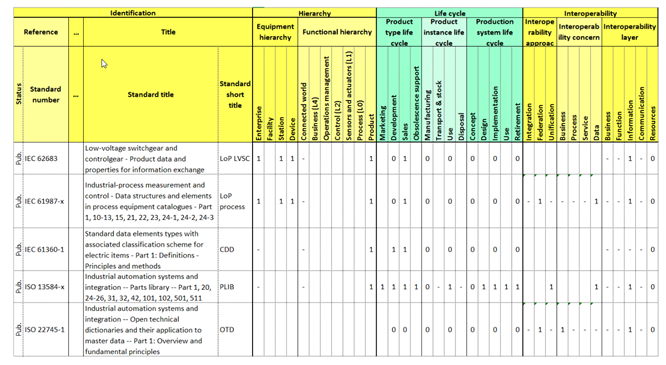
Standard Cell Industry 4.0 - frequently asked questions
1. How do ISO and IEC define ‘Industry 4.0’?
‘Industry 4.0’ represents the industrial future in which products, machines, production sites, etc. exchange information, interact and recognise each other. Initially an appropriately chosen marketing term, the necessity for a specific definition emerged as a fundamental element, enabling standards organisations to harmonise their activities and offer each other mutual support. ISO and IEC worked together extensively to reach a consensus on the appropriate term and its definition. Both ISO and IEC have opted for the term ‘Smart Manufacturing’. The definition below was adopted following the meeting held by the ISO Smart Manufacturing Coordinating Committee (ISO TMB/SMCC) in Stockholm, on 20 February 2018.
smart manufacturing
manufacturing that improves its performance aspects with integrated and intelligent use of processes and resources in cyber, physical and human spheres to create and deliver products and services, which also collaborates with other domains within enterprises’ value chains.
Note 1 to entry: Performance aspects include agility, efficiency, safety, security, sustainability or any other performance indicators identified by the enterprise
Note 2 to entry: In addition to manufacturing, other enterprise domains can include engineering, logistics, marketing, procurement, sales or any other domains identified by the enterprise
All definitions drawn from standards are considered as interpretations of the first.
Industry 4.0 or Smart Manufacturing is therefore a generic term encompassing a whole range of fields and technologies. It refers to a global industrial method that largely relies on the latest technologies pertaining to connected production-related resources aimed at transforming the manufacturing environment to offer increased flexibility and agility, together with benefits in terms of time-saving, quality and costs. Products, production processes and factories combine to form a huge 'Cyber Physical Production System' (CPPS) which is largely self-regulated by machine-object interactions. Once connected, systems communicate with each other and are capable of self-regulating without any centralised control. The production plant can be configured based on needs via the addition or removal of modules thanks to plug and work functions.
Smart Manufacturing is one of the IOT applications, or more specifically IIOT, i.e. the Industrial Internet of Things.
2. Is there a unified reference model architecture for the concept of ‘Smart manufacturing’?
The aim of a unified reference model is to: provide a reference base for understanding the significant relationships between entities and practice in smart manufacturing; to define an approach for developing standards and other specifications particular to a given industry or country.
One confusing issue for industry is that there are currently several competing reference architectures, such as RAMI4.0 (Reference Architecture Model Industry4.0), proposed by the German initiative Industry4.0, IIRA (Industrial Internet Reference Architecture Model Industry4) by the IIC (Industrial Internet Consortium) coordinated by the United States, and many more.
In an aim to harmonise existing reference models and to supervise the development of underlying architectures, a joint work group has been created between the ISO/TC 184 ‘Automation systems and integration’ and the IEC/TC 65 ‘Industrial process measurement, control and automation’ committees. The resulting group has been named JWG 21 ‘Smart Manufacturing Reference model(s)’, and reunites 70 experts from 13 different countries. The JWG’s role is to prepare a standardised, unified reference model to support ISO/TC184 and IEC/TC65 activities in the field of smart manufacturing. The first phase will involve the elaboration of a meta-modelling concept that can host all the key characteristics of each proposed reference model, and represent them in a uniform manner via abstract language. This project will be materialised in April 2021 via the publication of a technical report - IEC TR 63319 ED1: A meta-modelling analysis approach to smart manufacturing reference models (SMRM)
This meta-model will provide the ‘language’ for launching the second phase which will consist in specifying a Unified Reference Model. This standards project - PNW65-815 ‘Unified reference model for smart manufacturing’ was initiated in June 2020 and will be completed within 3 years.
3. What are the greatest stakes and challenges generated by smart manufacturing?
One first challenge is to associate the physical and digital worlds throughout an ‘asset’s’ life cycle. The associated stakes are therefore: interoperability or the capacity to synchronise a group of elements (products, machines, processes, factory, virtual models, etc.) from different manufacturers and that evolve in an independent manner; management of a complexity and great quantity of data and their exploitation, digital sovereignty and therefore cybersecurity within strongly converging IT (information technology) / OT (operational technology) environments. Hence, smart manufacturing may only be achieved if machine and equipment manufacturers design smart ‘assets’ which are:
- Capable of reliably, efficiently and safely collaborating with ‘assets’ from other manufacturers, according to consensus-based standards rather than proprietary standards. For both users and manufacturers, this represents a pledge of trust and the necessary security for such an investment. These interoperable solutions based on open systems and interfaces will preserve the opening-up of markets, will stimulate innovation and will allow service portability within the unique digital market.
- ‘Secured by design’, i.e. with integrated security as from their design phase.
A second challenge involves the importance of the human factor in production systems, via several themes: physical and cognitive assistance, ergonomics, skills and knowledge adaptation, augmented reality, etc. Stakes include issues on health and safety at work (accidents, fatigue, stress, MSDs, etc.) that are worthy of in-depth consideration during the various design and exploitation phases of work-related equipment.
4. How can ISO and IEC standards help to overcome such challenges?
ISO and IEC committees have been highly active for a long time now, in the fields of automation and manufacturing. Standards focus, not only on given technologies or specific aspects, but on the system as a whole, and on the integration of subsystems and components.
To improve our understanding of the stakes involved in Industry 4.0 standardisation, the German Standardisation Roadmap for Industry 4.0 is a very useful source. It is one of the essential communication tools for Industry 4.0. It enables the national and international exchange of information between standards organisations, industry, associations, research and political entities. It provides a guide that paves the way for active individuals and organisations in various technology sectors, and presents the results of ongoing work and debates, together with an insight into the standards and specifications that are pertinent to Industry 4.0. Since the previous version (v3), the DIN and the DKE published major recommendations for action at national level, in the form of standardisation projects, which were later implemented on a national scale. The fourth version of the standardisation roadmap focuses on interoperability and the tools required to achieve it. It also deals, for the first time, with the use of artificial intelligence (AI) in industrial applications.
Also worthy of note, in partnership with the European Multi Stakeholder platform on ICT Standardisation, the European Commission updates the Rolling Plan for ICT Standardisation every year. The document details all subjects identified as EU political priorities and for which standardisation, standards or technical specifications pertaining to ICT should play a leading role in their implementation. It covers technologies of ‘horizontal importance’, those whose application seriously impacts different technical fields, within the context of ICT infrastructures and ICT standardisation. The Industry 4.0 Standards Cell follows several technical committees working on the Rolling Plan’s priority work themes, such as Advanced Manufacturing, Robotics and Autonomous Systems, Cybersecurity and Data Protection.
5. What standard ecosystem exists for smart manufacturing?
The standard ecosystem for smart manufacturing is particularly complex.
Alongside ISO/TC 299 Robotics (previously TC 184/SC2) and ISO/TC 199 Safety of Machinery, which deal with the technical security of collaborative robotic systems, the committees and numerous consortiums involved in Industry 4.0 are as follows:
Given that the various standardisation groups are active in fields related to standardisation, IEC and ISO have formed coordination groups. Following advice from the ISO SAG SM/I4.0 strategy group, ISO created the Smart Manufacturing Coordination Committee - ISO/SMCC) and IEC created the Smart Manufacturing System Committee - IEC SEG 7, now renamed the Smart Manufacturing System Evaluation - IEC/Syc SM.
Standards and good practices are developed within consortiums. For example, the VDMA (German federation of mechanical engineering) was quick to acknowledge that the definition of an international language is crucial for the future of mechanical engineering and production plant construction. After adopting OPC UA as the reference standard for data exchange, the VDMA became aware of the necessity to add other specifications, based on the former, in order to reach a universal interface capable of enabling machine tools of different brands, not only to enter into dialogue with each other, but also with other enterprise software solutions, such as ERP (Enterprise Resource Planning) and MES (Manufacturing Execution Systems), clouds, automation systems, etc. With this aim in mind, in 2020, the VDW and the VDMA announced the pooling of their teams to define interoperability standards for the mechanical sector. These interoperability standards are disseminated under the UMATI label. They will concern electrically driven machines, machines for plastic and rubber, machine vision, robotics and machine tools.
Also worthy of mention, the Atlas Copco initiative, with the recent launch of its first series of OPC UA-enabled compressors. Through use of the powerful modelling language offered by OPC UA, Atlas Copco has defined a digital representation of its products. Via its participation as leader of a consortium of industrial and academic partners on behalf of the OPC Foundation, Atlas Copco is also committed to bringing the entire compressed air industry in line with digital standardisation. The aim of such an effort is to create a standard representation of a compressed air system on an industrial scale. Once the complementary specification published, a simple software update will suffice to bring Atlas Copco’s machines within total confirmity with the new standard.
6. Is there a standards catalogue for smart manufacturing?
A standards catalogue for smart manufacturing is currently being compiled. It is the result of a joint IEC - ISO initiative, via the common work group SM2TF ‘Smart manufacturing standards map Task Force’. The work group’s aim is to generate and organise a catalogue of standards for the committees involved in smart manufacturing, in order to facilitate searches with standardised criteria, following the example of the existing Smart Grid. The specification for the catalogue and its viewing tool are the subjects of two technical reports. The first, entitled, ISO/IEC TR 63306-1 SM2 Framework, was published late 2020. The final version of the second part, entitled ISO/IEC TR 63306-2 SM2 Catalogue, will be published during the first semester of 2021.
In concrete terms, an initial version of the SM2 catalogue can be consulted in Excel format here. Pertinent standards for smart production are listed in different themes.
Various 2D or 3D graphic representations can be generated from the SM2 catalogue. The type of graphic representation will depend on the viewpoint selected by stakeholders.
7. What standards are monitored on a priority basis by the Industry 4.0 Standards Cell?
The Industry 4.0 Standards Cell focuses in particular on standards dealing with:
- Unified reference model for smart manufacturing
- Standardised digital representations of interconnected physical entities within an information framework that provides an integrated view of life cycles (digital twin and digital thread)
- Industrial Internet of things with an infrastructure enabling the interconnection of distributed entities, inside and outside the organisation
- Information standards, both traditional standard information models and emerging communication protocols based on service-oriented architectures. Information standards describe the type of information that can be recorded and how. Through the use of information standards, data which can be requested, shared, exchanged and transferred, are recorded in information systems with the same quality requirements. This ensures that systems exchange data in the same way. If the exchange is not standardised, information can become entangled in different ‘languages’.
- Communication networks with a robust and secure communication infrastructure to ensure both machine safety and industrial safety.
- Man-machine interaction: the design and implementation of robotic systems that interact with humans must consider the safety and well-being of workers interacting with advanced robotic systems and smart machines.
and that are applicable in smart production applications such as:
- Transparent and digital factory: digital technology enabling the modelling, communication and exploitation of the manufacturing process. It supports the design, configuration, monitoring and control of a production system.
- Advanced robotics and smart machines: systems that operate in an autonomous manner, that communicate, adapt and potentially learn, that are capable of solving problems and taking decisions, independently of humans, whenever necessary.
These standards for smart manufacturing can be of different types: baseline standards, terminology standards, test standards, product standards, process standards, interface standards, standards on data to be provided.
Would you like to discover current good practices, recently proposed European and international standards, standards pending revision and standards that are currently the subject of a public enquiry, or have recently been published in the field? Then we invite you to consult the following articles on the subject:
Transparent and digital factory:
[September 2020] Revised standard to facilitate exchange of information on production system
[October 2020] Umati becomes the universal smart factory language
Advanced robotics and smart machines:
[July 2020] The challenges of mobile robot security
[February 2021] ‘Robots’ and ‘Robotic systems’ standards are still on the move
Other subjects will be approached shortly. Please feel free to forward your current challenges and priorities (veronique.dossogne@sirris.be ) so that can take them into account.

Want to know more about the standards cell industry 4.0?
Véronique Dossogne is happy to help!



